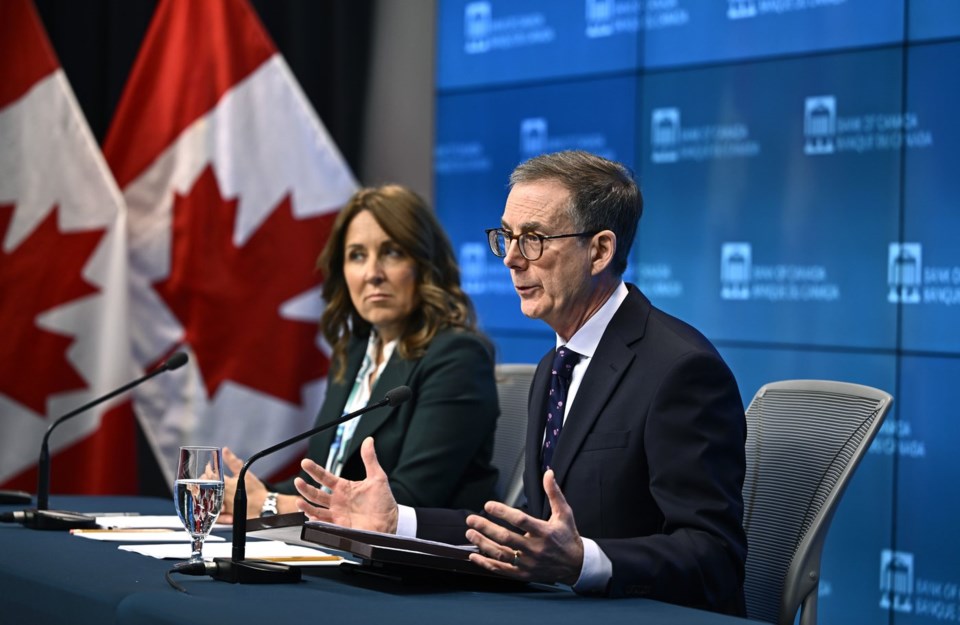OTTAWA — The potential for a long trade war with the United States, and the uncertainty it brings even if the threat isn’t realized, weighed heavily on the Bank of Canada’s governing council when it decided to cut interest rates last month.
The central bank released a summary of its deliberations on Wednesday. The document offers a glimpse into the council’s discussions ahead of the Jan. 29 rate cut, when it lowered its policy rate by a quarter-percentage point to three per cent — its sixth straight cut.
It showed the governing council had a long discussion on the impact of prolonged trade uncertainty, considering survey data released last month showed some businesses were already considering shifting investments to the U.S.
“Members also agreed that the threat of tariffs had increased uncertainty, and this would weigh on business confidence and investment intentions, as well as consumer sentiment,” the report reads.
"This also supported the case for a lower policy rate.”
U.S. President Donald Trump has mused hitting Canadian imports with a blanket 25 per cent tariff since before he took office. He initially signaled he’d do it his first day in the role, then later revised the deadline to the start of February.
The tariffs were ultimately paused for 30 days after Canada reached a deal to satisfy American concerns over fentanyl — though less than one per cent of all fentanyl entering the U.S. comes from Canada — including appointing a "fentanyl czar” and listing drug cartels as terrorist entities, among other provisions.
But the impact of prolonged what-ifs on the Canadian economy, and the different scenarios tariffs and any retaliatory measures would present, meant the Bank of Canada wasn’t comfortable providing insight on its interest rate plans moving forward.
“Members agreed that it would be important to provide Canadians with their updated analysis and assessments of the impact of a trade conflict on the economy and inflation as it unfolds,” the summary said, meaning the bank will provide updates if its analysis from trade war developments materially changes its outlook.
The discussion of how to keep Canadians informed comes after the bank released a report last month on its performance during the pandemic, noting it could better communicate how it plans to handle large-scale economic shocks.
A panel of experts who performed an external review of the bank's report agreed on the Bank of Canada's need to improve communication and transparency, particularly around the use of unconventional tools.
“All in all, there are a number of ways by which the bank could continue to refine and explore accessible methods to communicate its policy decisions,” the external review said.
The rapidly unfolding developments make it "impossible to predict what would happen with U.S. trade policy," the council members acknowledged as they weighed the effects a trade war would have on the Canadian economy.
Along with declining GDP, Canada's response to tariffs would put upward pressure on inflation.
The council agreed monetary policy needed to weigh the downward pressure on inflation from weakness in the economy, with upward inflation pressure from a trade war.
"Governing council members agreed that monetary policy cannot offset the long-term economic adjustment that permanent tariffs would cause. And in the short run, monetary policy cannot lean against lower growth and higher inflation at the same time," the report read.
"But having restored low inflation and reduced the policy interest rate substantially, monetary policy is better positioned to help smooth the economy’s adjustment to a tariff shock."
Council members were encouraged by recent indicators which showed the economy was picking up steam, and inflation holding steady at its two per cent target.
Still, other indicators still showed softening in the job market. Despite adding 91,000 jobs in December, the unemployment rate at the time was 6.7 per cent, and new entrants into the market — namely younger workers and newcomers — were finding it hard to get a job.
"Members agreed they needed to see this trend over a longer period to be convinced that the labour market was strengthening," the report said.
In deciding to cut the interest rate, the council agrees a quarter-percentage point cut would "would be helpful to support growth and better balance inflation risks."
This report by The Canadian Press was first published Feb. 12, 2025.
Nick Murray, The Canadian Press

